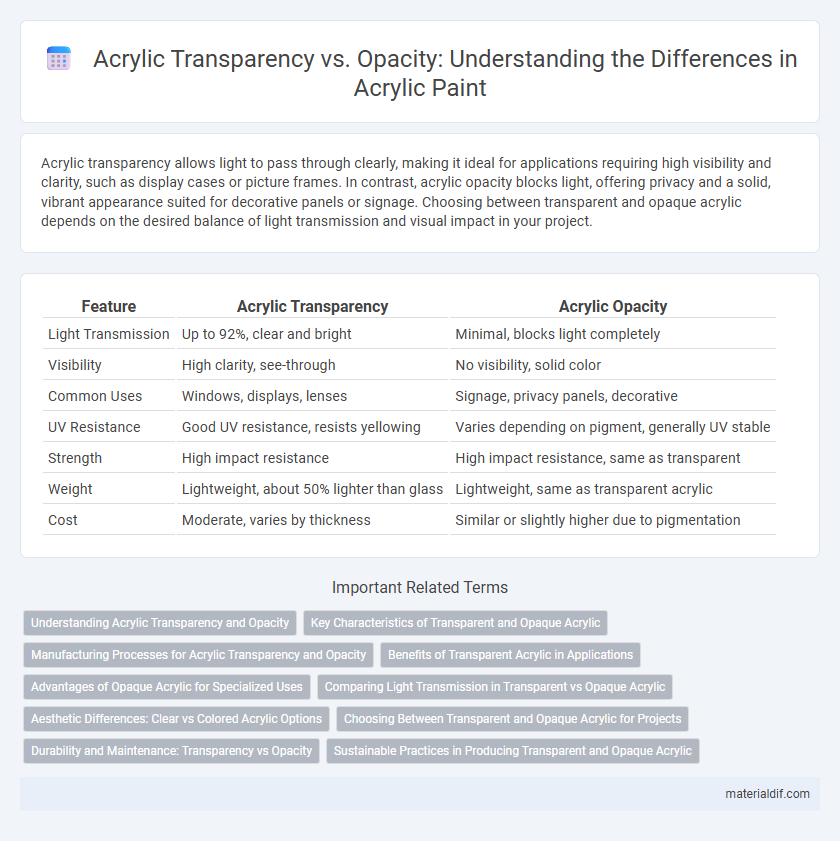Acrylic transparency allows light to pass through clearly, making it ideal for applications requiring high visibility and clarity, such as display cases or picture frames. In contrast, acrylic opacity blocks light, offering privacy and a solid, vibrant appearance suited for decorative panels or signage. Choosing between transparent and opaque acrylic depends on the desired balance of light transmission and visual impact in your project.
Table of Comparison
| Feature | Acrylic Transparency | Acrylic Opacity |
|---|---|---|
| Light Transmission | Up to 92%, clear and bright | Minimal, blocks light completely |
| Visibility | High clarity, see-through | No visibility, solid color |
| Common Uses | Windows, displays, lenses | Signage, privacy panels, decorative |
| UV Resistance | Good UV resistance, resists yellowing | Varies depending on pigment, generally UV stable |
| Strength | High impact resistance | High impact resistance, same as transparent |
| Weight | Lightweight, about 50% lighter than glass | Lightweight, same as transparent acrylic |
| Cost | Moderate, varies by thickness | Similar or slightly higher due to pigmentation |
Understanding Acrylic Transparency and Opacity
Acrylic transparency refers to the clear, see-through quality that allows light to pass through without significant distortion, making it ideal for applications like windows, displays, and optical lenses. Acrylic opacity, on the other hand, limits light transmission, providing privacy and reducing glare, which is useful in signage, furniture, and decorative panels. Understanding the balance between acrylic transparency and opacity helps manufacturers choose the right material for aesthetic appeal, functionality, and performance in various products.
Key Characteristics of Transparent and Opaque Acrylic
Transparent acrylic offers high light transmission up to 92%, providing crystal-clear clarity ideal for glazing, displays, and protective barriers. Opaque acrylic features low light transmission with solid color or frosted finishes, enhancing privacy and hiding underlying structures in signage and decorative panels. Both types deliver durability, UV resistance, and impact strength, but transparent acrylic is chosen for visibility while opaque acrylic is preferred for concealment and design versatility.
Manufacturing Processes for Acrylic Transparency and Opacity
Acrylic transparency is achieved through precise polymerization and controlled cooling processes that ensure a uniform molecular structure, reducing internal stresses and light scattering. Manufacturing acrylic opacity involves adding specific fillers, pigments, or dyes during polymerization, which disrupt light transmission by scattering or absorbing light waves. Techniques such as co-extrusion and surface texturing also influence acrylic's transparency or opacity, tailoring its optical properties for various industrial and design applications.
Benefits of Transparent Acrylic in Applications
Transparent acrylic offers exceptional clarity and light transmission, making it ideal for applications requiring visibility and aesthetic appeal, such as display cases, signage, and windows. Its high transparency enhances product presentation and allows natural light to pass through, reducing the need for artificial lighting and improving energy efficiency. Furthermore, transparent acrylic is lightweight, shatter-resistant, and UV-resistant, providing durable and safe alternatives to glass in both indoor and outdoor environments.
Advantages of Opaque Acrylic for Specialized Uses
Opaque acrylic offers superior light control and excellent UV resistance, making it ideal for applications that require reduced glare or protection from sunlight. Its non-transparent property enhances privacy and conceals underlying structures, beneficial for signage, displays, and architectural panels. This material also provides a durable, scratch-resistant surface that maintains vibrant color stability in demanding environments.
Comparing Light Transmission in Transparent vs Opaque Acrylic
Transparent acrylic offers high light transmission rates, typically allowing 90-92% of visible light to pass through, making it ideal for applications requiring clear visibility and natural illumination. In contrast, opaque acrylic significantly reduces light transmission, blocking nearly all visible light to provide privacy and UV protection. Comparing both, transparent acrylic maximizes clarity and brightness, while opaque acrylic prioritizes light blockage and surface coloration.
Aesthetic Differences: Clear vs Colored Acrylic Options
Clear acrylic offers exceptional transparency, providing a glass-like clarity that enhances visual depth and light transmission in design projects. Colored acrylic options introduce varying degrees of opacity, allowing for creative uses of light diffusion and vibrant hues that contribute to distinctive aesthetic appeal. Choosing between clear and colored acrylic depends on the desired balance between visibility and color impact in architectural or artistic applications.
Choosing Between Transparent and Opaque Acrylic for Projects
Choosing between transparent and opaque acrylic depends on the project's need for light transmission and privacy. Transparent acrylic offers high clarity and allows maximum light to pass through, making it ideal for display cases, windows, and protective barriers. Opaque acrylic provides solid color options and blocks light completely, perfect for signage, decorative panels, and applications requiring privacy or light control.
Durability and Maintenance: Transparency vs Opacity
Acrylic transparency offers high clarity and resists yellowing over time, ensuring long-lasting visual appeal with minimal maintenance. Opaque acrylics provide enhanced durability against scratches and impact, making them better suited for heavy-use environments. Both varieties require regular cleaning with non-abrasive solutions to maintain surface integrity and performance.
Sustainable Practices in Producing Transparent and Opaque Acrylic
Sustainable practices in producing transparent and opaque acrylic prioritize the use of eco-friendly raw materials and energy-efficient manufacturing processes to reduce environmental impact. Innovations in recycling acrylic waste and incorporating bio-based monomers contribute to decreasing carbon footprints while maintaining high-quality transparency or opacity in final products. These efforts align with industry standards for sustainable development and promote circular economy principles in acrylic production.
Acrylic Transparency vs Acrylic Opacity Infographic

 materialdif.com
materialdif.com